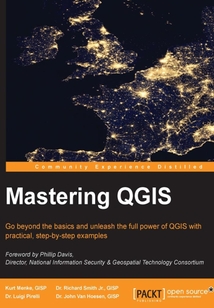舉報 

會員
Mastering QGIS
Kurt Menke GISP Dr. Richard Smith Jr. GISP Dr. Luigi Pirelli Dr. John Van Hoesen GISP 著
更新時間:2021-07-23 19:48:00
開會員,本書免費讀 >
最新章節:
Index
IfyouareaGISprofessional,aconsultant,astudent,orperhapsafastlearnerwhowantstogobeyondthebasicsofQGIS,thenthisbookisforyou.ItwillprepareyoutorealizethefullpotentialofQGIS.
最新章節
- Index
- Summary
- Interacting with the map canvas
- Running an external algorithm or command
- Running processing toolbox algorithms
- Editing features
品牌:中圖公司
上架時間:2021-07-23 18:58:30
出版社:Packt Publishing
本書數字版權由中圖公司提供,并由其授權上海閱文信息技術有限公司制作發行
- Index 更新時間:2021-07-23 19:48:00
- Summary
- Interacting with the map canvas
- Running an external algorithm or command
- Running processing toolbox algorithms
- Editing features
- Iterating over features
- Vector structure
- Loading layers
- Where to learn Python basics
- Chapter 10. PyQGIS Scripting
- Summary
- Debugging session example
- Setting up a debugging environment
- A simple plugin example
- Creating a plugin structure with Plugin Builder
- Exploring a QGIS API in the Python Console
- Exploring iface and QGis
- The Python Console
- Webography - where to get API information and PyQGIS help
- Chapter 9. Creating QGIS Plugins with PyQGIS and Problem Solving
- Summary
- Converting a model into a Python script
- Using batch processing with models
- Nesting models
- Executing model algorithms iteratively
- Saving loading and exporting models
- Documenting a model
- Editing a model
- Running a model
- Adding algorithms
- Adding inputs
- Configuring the modeler and naming a model
- Opening the graphical modeler
- An introduction to the graphical modeler
- Chapter 8. Automating Workflows with the Graphical Modeler
- Summary
- R
- Exploring hydrologic analyses with TauDEM
- SAGA
- Performing raster analyses with GRASS
- About the processing toolbox
- Chapter 7. The Processing Toolbox
- Summary
- Repairing topological errors via topological editing
- Checking the topology of vector data
- Georeferencing imagery
- Geocoding address-based data
- Creating points from coordinate data
- Chapter 6. Advanced Data Creation and Editing
- Summary
- Creating raster surfaces via interpolation
- Converting between raster and vector data models
- Generating raster overviews (pyramids)
- Creating a raster mosaic
- Rescaling rasters
- Reclassifying rasters
- Chapter 5. Preparing Raster Data for Processing
- Summary
- Complex spatial and aspatial queries
- Advanced field calculations
- Defining coordinate reference systems
- Using basic vector geoprocessing tools
- Converting vector geometries
- Checking for geometry errors
- Creating spatial indices
- Merging shapefiles
- Chapter 4. Preparing Vector Data for Processing
- Summary
- Saving loading and setting default styles
- Using diagrams to display thematic data
- Vector layer rendering
- Styling vectors
- Raster resampling
- Raster color rendering
- Creating a raster composite
- Styling multiband rasters
- Styling single band rasters
- Managing color ramps
- Choosing and managing colors
- Chapter 3. Styling Raster and Vector Data
- Summary
- Creating queries and views
- Managing tables
- Exporting tables out of SpatiaLite as a shapefile
- Importing data into a SpatiaLite database
- Creating a spatial database
- Fundamental database concepts
- Chapter 2. Creating Spatial Databases
- Summary
- Adding functionality with plugins
- Composing maps
- Editing data
- Working with tables
- Working with coordinate reference systems
- Loading data
- Tour of QGIS
- QGIS download and installation
- Chapter 1. A Refreshing Look at QGIS
- Customer support
- Reader feedback
- Conventions
- Who this book is for
- What you need for this book
- What this book covers
- Preface
- Support files eBooks discount offers and more
- www.PacktPub.com
- About the Reviewers
- About the Authors
- Foreword
- Credits
- Mastering QGIS
- coverpage
- coverpage
- Mastering QGIS
- Credits
- Foreword
- About the Authors
- About the Reviewers
- www.PacktPub.com
- Support files eBooks discount offers and more
- Preface
- What this book covers
- What you need for this book
- Who this book is for
- Conventions
- Reader feedback
- Customer support
- Chapter 1. A Refreshing Look at QGIS
- QGIS download and installation
- Tour of QGIS
- Loading data
- Working with coordinate reference systems
- Working with tables
- Editing data
- Composing maps
- Adding functionality with plugins
- Summary
- Chapter 2. Creating Spatial Databases
- Fundamental database concepts
- Creating a spatial database
- Importing data into a SpatiaLite database
- Exporting tables out of SpatiaLite as a shapefile
- Managing tables
- Creating queries and views
- Summary
- Chapter 3. Styling Raster and Vector Data
- Choosing and managing colors
- Managing color ramps
- Styling single band rasters
- Styling multiband rasters
- Creating a raster composite
- Raster color rendering
- Raster resampling
- Styling vectors
- Vector layer rendering
- Using diagrams to display thematic data
- Saving loading and setting default styles
- Summary
- Chapter 4. Preparing Vector Data for Processing
- Merging shapefiles
- Creating spatial indices
- Checking for geometry errors
- Converting vector geometries
- Using basic vector geoprocessing tools
- Defining coordinate reference systems
- Advanced field calculations
- Complex spatial and aspatial queries
- Summary
- Chapter 5. Preparing Raster Data for Processing
- Reclassifying rasters
- Rescaling rasters
- Creating a raster mosaic
- Generating raster overviews (pyramids)
- Converting between raster and vector data models
- Creating raster surfaces via interpolation
- Summary
- Chapter 6. Advanced Data Creation and Editing
- Creating points from coordinate data
- Geocoding address-based data
- Georeferencing imagery
- Checking the topology of vector data
- Repairing topological errors via topological editing
- Summary
- Chapter 7. The Processing Toolbox
- About the processing toolbox
- Performing raster analyses with GRASS
- SAGA
- Exploring hydrologic analyses with TauDEM
- R
- Summary
- Chapter 8. Automating Workflows with the Graphical Modeler
- An introduction to the graphical modeler
- Opening the graphical modeler
- Configuring the modeler and naming a model
- Adding inputs
- Adding algorithms
- Running a model
- Editing a model
- Documenting a model
- Saving loading and exporting models
- Executing model algorithms iteratively
- Nesting models
- Using batch processing with models
- Converting a model into a Python script
- Summary
- Chapter 9. Creating QGIS Plugins with PyQGIS and Problem Solving
- Webography - where to get API information and PyQGIS help
- The Python Console
- Exploring iface and QGis
- Exploring a QGIS API in the Python Console
- Creating a plugin structure with Plugin Builder
- A simple plugin example
- Setting up a debugging environment
- Debugging session example
- Summary
- Chapter 10. PyQGIS Scripting
- Where to learn Python basics
- Loading layers
- Vector structure
- Iterating over features
- Editing features
- Running processing toolbox algorithms
- Running an external algorithm or command
- Interacting with the map canvas
- Summary
- Index 更新時間:2021-07-23 19:48:00


